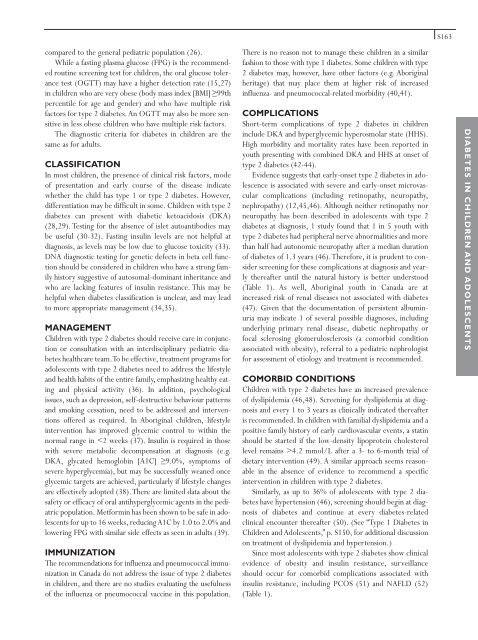2008 Clinical Practice Guidelines - Canadian Diabetes Association
2008 Clinical Practice Guidelines - Canadian Diabetes Association
2008 Clinical Practice Guidelines - Canadian Diabetes Association
Create successful ePaper yourself
Turn your PDF publications into a flip-book with our unique Google optimized e-Paper software.
compared to the general pediatric population (26).<br />
While a fasting plasma glucose (FPG) is the recommended<br />
routine screening test for children, the oral glucose tolerance<br />
test (OGTT) may have a higher detection rate (15,27)<br />
in children who are very obese (body mass index [BMI] ≥99th<br />
percentile for age and gender) and who have multiple risk<br />
factors for type 2 diabetes. An OGTT may also be more sensitive<br />
in less obese children who have multiple risk factors.<br />
The diagnostic criteria for diabetes in children are the<br />
same as for adults.<br />
CLASSIFICATION<br />
In most children, the presence of clinical risk factors, mode<br />
of presentation and early course of the disease indicate<br />
whether the child has type 1 or type 2 diabetes. However,<br />
differentiation may be difficult in some. Children with type 2<br />
diabetes can present with diabetic ketoacidosis (DKA)<br />
(28,29). Testing for the absence of islet autoantibodies may<br />
be useful (30-32). Fasting insulin levels are not helpful at<br />
diagnosis, as levels may be low due to glucose toxicity (33).<br />
DNA diagnostic testing for genetic defects in beta cell function<br />
should be considered in children who have a strong family<br />
history suggestive of autosomal-dominant inheritance and<br />
who are lacking features of insulin resistance. This may be<br />
helpful when diabetes classification is unclear, and may lead<br />
to more appropriate management (34,35).<br />
MANAGEMENT<br />
Children with type 2 diabetes should receive care in conjunction<br />
or consultation with an interdisciplinary pediatric diabetes<br />
healthcare team.To be effective, treatment programs for<br />
adolescents with type 2 diabetes need to address the lifestyle<br />
and health habits of the entire family, emphasizing healthy eating<br />
and physical activity (36). In addition, psychological<br />
issues, such as depression, self-destructive behaviour patterns<br />
and smoking cessation, need to be addressed and interventions<br />
offered as required. In Aboriginal children, lifestyle<br />
intervention has improved glycemic control to within the<br />
normal range in 4.2 mmol/L after a 3- to 6-month trial of<br />
dietary intervention (49). A similar approach seems reasonable<br />
in the absence of evidence to recommend a specific<br />
intervention in children with type 2 diabetes.<br />
Similarly, as up to 36% of adolescents with type 2 diabetes<br />
have hypertension (46), screening should begin at diagnosis<br />
of diabetes and continue at every diabetes-related<br />
clinical encounter thereafter (50). (See “Type 1 <strong>Diabetes</strong> in<br />
Children and Adolescents,” p. S150, for additional discussion<br />
on treatment of dyslipidemia and hypertension.)<br />
Since most adolescents with type 2 diabetes show clinical<br />
evidence of obesity and insulin resistance, surveillance<br />
should occur for comorbid complications associated with<br />
insulin resistance, including PCOS (51) and NAFLD (52)<br />
(Table 1).<br />
S163<br />
DIABETES IN CHILDREN AND ADOLESCENTS











